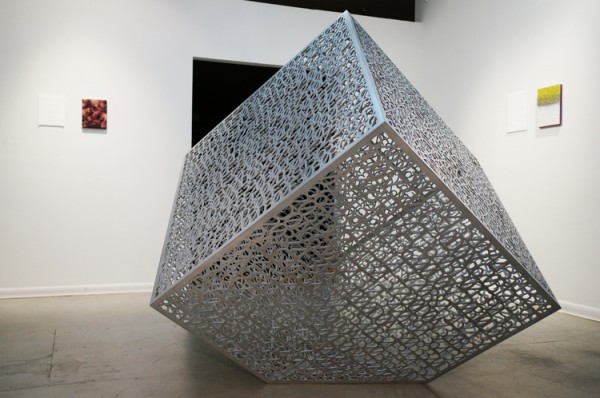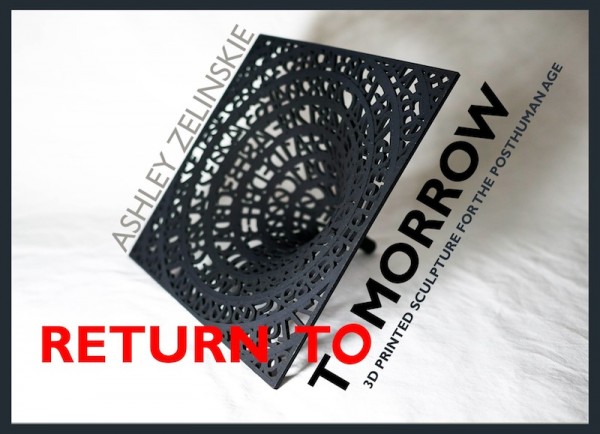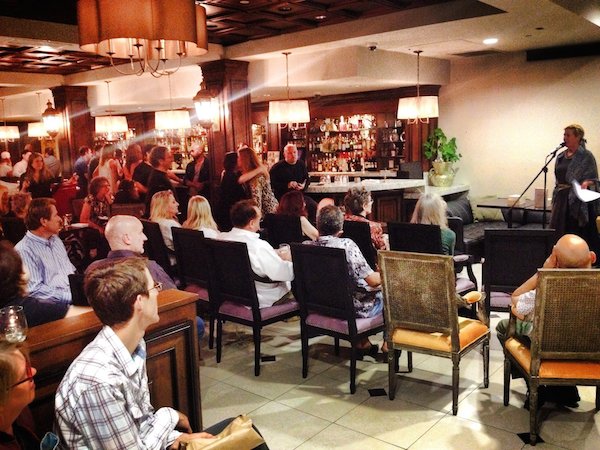A few years ago, Ashley Zelinskie crowdsourced her first Makerbot kit, with the idea that the 3D printer would help her realize her contribution to a widely known conceptual artwork by Joseph Kosuth, One and One Chair. Her idea was not just to print a chair, but to render the alphanumeric characters that formed the 3D design code itself. In this way, she was rendering not just the chair in 3D, but the chair’s code, as well. The lace-like design of thin letters and numbers were a challenge for Wall.e, her first Makerbot, and as she struggled for days and weeks (and then months and years) to push this technology and other printers to create the work, she learned how to hack the printers, tweak her designs, and moved into an entire body of work, Reverse Abstractions.
This series (constructed with 3D printers as well as other fabrication processes) continues to express the duality she exposes with One and One Chair. In Reverse Abstraction, familiar objects (a 3D hexagon) or familiar artworks (Mona Lisa) have become self-referential renderings that point back not to the artist but to themselves. She’s also created works that render nondimensional concepts, like pi, in 3D.
As a conceptual artist, Ashley’s work synthesizes art history with tech and distills millions of lines of code into very deceptively “simple” objects that she calls “art for computers.” On the occasion of her first exhibition, Return to Tomorrow (Wednesday, March 11, in Brooklyn), we talked about some of her favorite things: art, tech, and of course, Spock. The following is a lightly condensed transcript of the conversation.

RG: Why is your show named Return to Tomorrow?
AZ: Return to Tomorrow is the name of a Star Trek episode from the original series https://en.wikipedia.org/wiki/Return_to_Tomorrow. The Enterprise is guided to a distant, long-dead world where survivors of an extremely ancient race – existing only as disembodied energy—desiring the bodies of Kirk, Spock and astrobiologist Ann Mulhall so that they may live again. They get robot bodies! http://www.amazon.com/gp/product/B000HW7FOK/ref=atv_feed_catalog?ref_=imdbref_tt_pv_vi_aiv_1&tag=imdbtag_tt_pv_vi_aiv-20. You can watch it if you want. I thought it applied to my idea of transcribing the essence of humanity into something robots can understand.
RG: What is your idea of the essence of humanity? Are we an ancient race?
AZ: No, I don’t think we are yet. But I do think that Art is the essence of humanity and that collectors work very hard to protect these little pieces of time and culture. I am trying to make work that will survive into an era of technology that will push these “ancient” ideas forward for audiences that haven’t been born yet. “born.”
RG: “Born?”
AZ: Humans that haven’t been born or whatever is next to be created I guess would be a good word. Robots aren’t born, they are created. But maybe they will be born. Who knows. That is part of the struggle of making art that hopes to be relevant even in the future. Why is there no robot emoji for times like this? ???? I guess that will do.
RG: Your idea is to transcribe the essence of humanity, but your art is often created from objects that were created by hand, then mediated through a computer and machines. (I can’t see the emoji because…you know. I am vintage.)
AZ: Haha. Oh. Yeah, I like taking old works of art, old ideas that are reused throughout history and making them relevant to today and tomorrow.
RG: But if art is the essence of humanity, isn’t art something that should be made by hand?
AZ: Why does it need to be made by hand to be the essence of humanity if the machines making it are made by human humans? Even if those machines are made by machines it’s kinda like, what is natural, right? Like everything is “natural,” it comes from the earth, we have no where else to get it from. We just make it into something different. Where does that line end? Sorry that was a tangent, let’s get back to being not stoned.
RG: Do you consider the art object to be the idea or the thing that is created from the idea?
AZ: No, it is the idea. Most art now isn’t even made by the artist, people just don’t know that. I don’t think that matters anymore though, because we expect artists to make artwork in many forms, and we can’t be pro craftsmen at everything.
RG: Please explain Reverse Abstraction. What is it?
AZ: Reverse Abstraction is a series I have been working on for a while now. I am finally getting to show it all at once in one large space so YAY. It stems from the idea of Joseph Kosuth and Plato before him, how the same idea is passed on through generations in different forms. Joseph Kosuth and Plato (and many others) questioned the idea of the true nature of objects. What the reality of these objects actually is, is it the object or the idea or the image? Kind of like that question you just asked about art.
RG: We tend to see technology as cold, something we only observe indirectly, in its effects. In creating art objects that have their own aesthetics but are also technology-based, are you trying to help people see the beauty in technology?
AZ: Well, Kosuth posed this question with a chair, a picture of a chair, and a definition of a chair. I do it with one object—a chair that is made of its own computer code. I would like to people to see the beauty in technology. There is so much beauty in the way things work. When learning about how computers “think,” I have so many AH HA moments, because it is the way we think, too. Weird, right… since we made them… we created in our image. #god
They think in math
and math is very logical
and well organized
so it is very satisfying to my OCD tendencies
and makes for nice clean art.
![oneandonechair4[detail]](http://robingrearson.com/wp-content/uploads/2015/03/oneandonechair4detail-600x428.jpg)
RG: How is the chair made of its own computer code?
AZ: The chair started out as a 3D model on a computer, that is a file like any other file. It is made of code, like the matrix almost. The computer sees all your files as code. I just took the code that is hidden beneath and placed it on top. Art can be anything now.
RG: Technology is leading us to create more objects made by machines, do you see that as opening up what “art” is—what about video, multimedia, light, sound based art, etc.?
AZ: We are past the constraints of figuring out realist painting, we know vanishing points and perspective. Now what is left to figure out is ideas. Ideas can be anything, technology is allowing us to have new ideas and create new things. So artists need to put down the paint brush and pick up the mouse.
RG: But all ideas are not art, so then, what is art?
AZ: Art is exploration. Exploration with no intention to be logical.
RG: How should we be viewing or experiencing art differently if we don’t have to worry about rooms and boxes to create the context for us, “This Space Contains Art.”
Is it possible to be illogical inside technology? Maybe I mean “how can we,” or “how will we” experience art, and not how “should” we?
AZ: I think as artists we always need to question how we are viewing art, it should always be changing and evolving, how we view art and the art itself should never be stagnant.
RG: Everyone has ideas, and explores those ideas. does that make everyone an artist?
AZ: I think everyone can be an artist… but it takes time. Because artists’ ideas are informed by art history, by a language that has been established. But that isn’t to say that not everyone can learn it.
RG: Our friend Pema Rinzin [founder of the New York Tibetan Art Studio] would say that for him, art is about creating work that conveys joy and emotion and energy to the viewer, through his painting. He places critical importance on the artist’s style as a signature. Do you think his objectives for art can be achieved without the human hand creating it? Would the work feel that same energy if it was designed with a mouse?
AZ: Yes. I don’t think for him it would be the same. I think it is important to him that he does the painting. But do I think it is possible to achieve his goal in another way, yes.
RG: I should go back and ask you the basics.
AZ: My fav color is green, I like cats, I am 27 years old, I live in Brooklyn.
RG: You don’t have a cat.
AZ: I have a gecko.
RG: Exactly. Do you like real cats or internet cats?
AZ: Both. But Patrick isn’t allergic to internet cats, so those are the ones I keep.
RG: If art can be printed by a computer, how does that change the nature of an artwork as one of a kind. Can I say, “I love this, but I want it smaller?,” does art from computer code make the forms more mutable or change exclusivity?
AZ: Artwork has been printed way before the computer. I use the same format as printmakers and photographers. You create an edition and you stick to it. Printmakers and photographers can make more prints if they want to, but it is frowned upon to re-edition and devalues the work.So artists don’t do it.
RG: There is an analog that if I wanted to buy the master, I would have to buy the code, didn’t Kosuth’s piece include directions?
AZ: Yes, Kosuth sold the directions to create his piece. The chair and the photo and definition were different sometimes. The same chair was used, but didn’t have to be. The art was the idea, and the idea was written on a paper, and that is what was collected (eventually the chair too, but not intentionally). I do make unique works too. Right now my works are low editions of three. Some works (that make no sense to be multiples) are unique. Or things that are a bitch to make, I only make one. I tried editioning some of the works to try out applying the idea of printmaking and photography to 3D printing because for some reason people think that this is a new idea somehow… that there could be multiple of something so easily. I am reminding them that we have been through this already.
RG: Do you find technology is where all of the unanswered questions are?
AZ: Yes, I get to decide what the rules are, which is cool. But then you have to pave the way, which is hard.
RG: Where do you come up against limits and frustrations in making? The way a painter is confined to canvas size, is there a comparison? What is that?
AZ: Code density. Code is really long, lots of letters and numbers. People don’t realize how much code goes into seeing a jpg on the computer. Hint hint, it’s millions of characters. So fitting the code on the objects is always a challenge. Also yea, I would love printers to get bigger and laser cutters to get bigger, obvs.

RG: Is an object always printed with all of the code that comes from its shape?
AZ: Not always. Sometimes it is a math joke, like pi having the numbers of pi on it. Now I am working on a portrait series where the code is DNA. So I am branching out from just self referential objects, but that was just my Reverse Abstraction series. I have many more rabbits in my hat. ????
RG: Shape and code are not inherently colorful. Are you expressing ideas that don’t rely on color or are there technology limits. Would you use color differently if the technology were already easier, I think that’s the question? I can’t see that thing.
AZ: It is a bunny. But yea right now I am focused on idea and form, so my work is mostly white or black, sculptures. I have a series of paintings that are laser cut, they have color. AndI have an exhibit coming up at the 3D print show in New York. I am making colorful sculptures for that, but I don’t use color unless I have a reason to.
RG: Tech has completely changed our lives. But do you think we get too immersed in the changes to see them?
AZ: Not at all. Ever talk to your grandma? She will make it clear to you. Older people don’t hesitate to keep you in perspective to how different things are.
RG: When you started trying to print this chair, you were creating art with technology sort of before the technology existed that could make the object to match your vision.
AZ: Yes. Don’t remind me. It happens a lot. Frustration.
RG: What is the thing you need now that probably won’t exist until tomorrow? Need/want?
AZ: An affordable large metal printer, because most of my sculptures cannot be cast, and I would like them to be in metal. I can print them in metal, but the scale isn’t there yet, and neither is my wallet. (At this point,shout out to my sponsor, Bold Machines.)
RG: Why do you identify with Star Trek, and how big a fan are you?
AZ: Okay Star Trek, yea, I like that. It is a show all about what I am doing, which is hypothesizing about the future, but so so far in the future that anything can happen, so your imagination runs wild. And sometimes you actually hit on something that ends up happening.
RG: Tell me about Spock?
AZ: I am in love with Spock. His ears are sexy. Leonard Nimoy is in the hospital right now. So sad, chest pains.
RG: I saw that and thought of you.
AZ: Hope he is okay. If he dies I am going to cry. They better shoot him into space to be reborn. [Post-interview: LLAP, Leonard Nimoy].
RG: Do you think you will be reborn as a robot?
AZ: I hope so. Robot legs can run way faster and robot hands can smash things easier. It would make taking out the trash a nicer experience. And robot body = no more gym.
RG: What about robot sex?
AZ: I already have a robot I have sex with. It is made by lelo. https://www.lelo.com/
RG: Yes, but you are not the robot.
AZ: Maybe sex will be more of a program you can run, endorphin-inducing program.
RG: Okay but isn’t that BORING!?
AZ: That is how your brain works already.
RG: Endorphin inducing program.
AZ: Read a Nero book. Love is just chemicals in your brain telling you that when you are around someone your adrenaline goes up and your brain dumps dopamine. We live in the matrix already. There is no spoon. You can get upset at this fact, or you can embrace it. I don’t think it makes love any less valid.
RG: Did we go in a circle? If human experiences are basically just programs, why does art matter?
AZ: Because art and love are the programs that make us more than machines, more than animals, more than survival. Maybe less love. Love = reproduction. But art= what? Why art? What purpose does it serve? None. So why do we do it. That is what makes us human. The nonsensical art program that we run to no end.
RG: And the nonsensical human program.
AZ: /loop
#duh
#robotlegsplease
RG: I have to go start the human work program now.
AZ: Okay. I have to go to the gym from my non robot ass because I ate a KILO of cheese when I was in Mexico.
Ashley Zelinskie is a conceptual artist based in Brooklyn. Return to Tomorrow opens March 11 and runs through April 15, at Kingsborough Community College (Arts & Sciences Building, Kingsborough Community College, City University of New York, 2001 Oriental Boulevard, Brooklyn, NY 11235. 718/368-5449.)
5 tags is an occasional interview series, subjects are asked to choose 5 tags to represent themselves.
Comments closed


